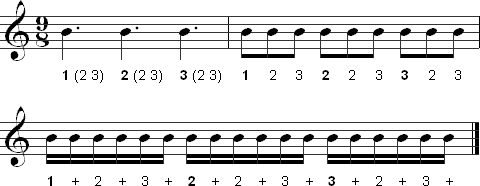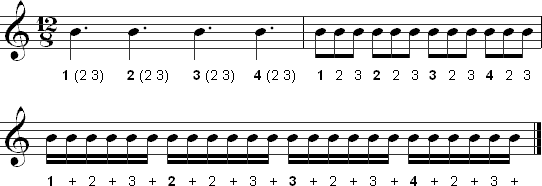Guide to Counting Common Rhythms
Counting Simple Rhythms
All of the musical examples are shown in 4/4 time until the section on compound time signatures. The counting method shown in 4/4 can easily be adapted to any other simple time signature. Commas are used to separate each beat, while dashes '-' are used to separate different words in the same beat. Words enclosed in parentheses are optional. '+' is used in the music to represent the word 'and' in order to reduce clutter in the musical examples.
Whole Notes
Count "one, two, three, four."

Half Notes
Count "one, two, three, four."

Quarter Notes
Count "one, two, three, four."

Eighth Notes
Count "one - and, two - and, three - and, four - and."

Triplets
Count "one - trip - let, two - trip - let, three - trip - let, four - trip - let."

Sixteenth Notes
Count "one - e - and - a, two - e - and - a, three - e - and - a, four - e - and - a" for steady sixteenth notes.

Below is a chart of common sixteenth note rhythms and how they are counted. Anything in parentheses is optional.
| Rhythm | Example |
|---|---|
| gallop |  |
| reverse gallop |  |
| sixteenth / eighth / sixteenth |  |
| dotted eight / sixteenth |  |
| sixteenth / dotted eighth |  |
Sixteenth Note Triplets
Count "one - trip - let - and - trip - let, two - trip - let - and - trip - let, three - trip - let - and - trip - let, four - trip - let - and - trip - let."

Thirty-second Notes
Thirty-second notes are often too fast to count every note, so they are usually counted like sixteenth notes, with two notes to each count.

An alternative is to count "one - e - and - a - and - e - and - a, two - e - and - a - and - e - and - a, three - e - and - a - and - e - and - a, four - e - and - a - and - e - and - a."

Counting in Compound Time Signatures
Counting in 6/8
Count eighth notes as "one - two - three, two - two - three." The count for other common rhythms is shown below:

Counting in 9/8
Eighth notes should be counted as "one - two - three, two - two - three, three - two three."

Counting in 12/8
Count eighth notes as "one - two - three, two - two - three, three - two - three, four - two - three."

Counting in Complex Time Signatures
Complex time signatures are time signatures like 5/4 or 7/8. These time signatures are usually divided into groups of twos, threes, and fours. The beaming of eighth note and smaller note values will show how the beats are grouped. The grouping of the beats is important because it affects how you count each group. Because beats in these time signatures are usually grouped into twos, threes, and fours, you should count each individual group of beats as shown below:
- group of two: count "one, two"
- group of three: count "one, two three"
- group of four: count "one, two, three, four"
The counting rules given previously can be used to deal with any subdivisions in these time signatures.
Counting in 5/4
5/4 is usually a combination of two and three or three and two.
Two Followed by Three
The grouping of two and three should be counted "one, two, one two three" as shown below:
Three Followed by Two
Three/two should be counted as "one, two, three, one, two."

Counting in 7/4
7/4 is usually a group of three followed by a group of four or a group of four followed by group of three. It is also possible to have groupings that include twos, but these are less common.
Three Followed by Four
Count the three/four grouping "one, two, three, one, two, three, four."

Four Followed by Three
Count the four/three grouping "one, two, three, four, one, two, three."

